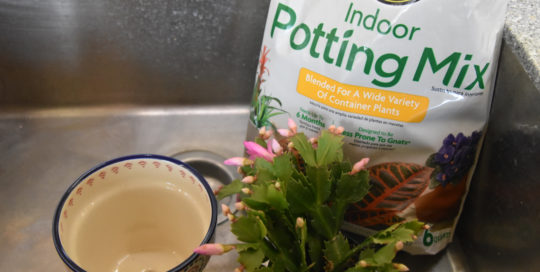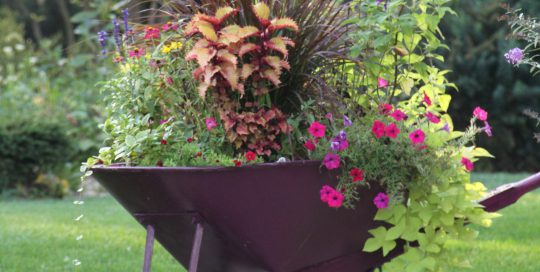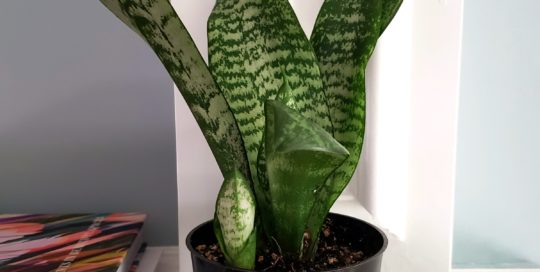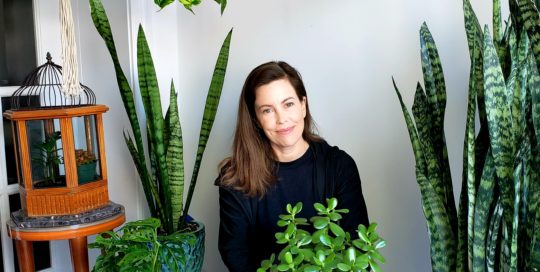Houseplants have a way of finding us. What may have started as an unexpected housewarming gift is likely to become a beloved green beauty taking up valuable real estate in your kitchen. Most of us start with one plant and soon find ourselves with half a dozen or more. Houseplants add color and life to a space, while also improving air quality.
The drawback to houseplants is that they can be rather finicky, and we often don’t know exactly how to care for them. Am I the only one who once poured leftover seltzer water on the office Ficus and hoped for the best?
To help you care for your photosynthesizing friends, I’ve listed the key ingredients for healthy houseplants, and some of the warning signs that something is amiss to assist in troubleshooting common issues.
Key Ingredients for Healthy Plants
Proper light exposure, soil conditions, essential nutrition, and water availability are the keys to healthy growth. And almost all issues can be solved by adjusting one of these.
Light
There are five categories of sunlight: direct, indirect, partial shade, full shade, and dense shade. Areas within the home likely range from full sun to full shade. Generally, windows that face east and south provide the most sunlight. Spend time online to learn the sunlight requirements of your specific plant. Supplement the light in dark areas with lightbulbs that mimic the spectrum in natural sunlight. An inappropriate amount of sun for your houseplants will lead to phototropism. That phenomenon occurs when a plant grows toward (or away from) a light source to regulate its intake. A simple way to offset this is to turn the pot 90 degrees once each month.
Houseplants that thrive in direct sunlight —
- Basil
- China Doll Plant
- Croton
- Jasmine
- Gardenia
- Ponytail Palm
- Sago palm
Houseplants that work with little sunlight —
- Cast iron plants
- Dracaenas
- Ivy
- Peperomias
- Philodendrons
- Pothos
- Spider plants
- Ivy
- ZZ plants
Soil
Soil provides plants with structure and stability. The roots anchor the above-ground stems and leaves. Potting soil should neither be compacted nor too loose. Roots enable the plant to intake nutrition and water, and for that matter, to breathe. Indoor plants are susceptible to disease and pests. You will save time and heartache in the long run by starting with sterile soil. That means all pathogens and parasites have been removed. This will increase the chances of growing healthy plants. The expense of high-grade commercial potting soil is negligible relative to the cost of pots and plants. Striving to save money on soil is the poster child for being penny-wise but pound-foolish. Whatever you do don’t use soil from the backyard!
Pro tip: When putting plants into fresh soil, gently pat the soil to remove large air pockets, and secure the plant with additional potting mix around the roots.
Nutrition
Plants are living things. Just like animals, plants require nutrition. The primary nutrients (of all living things, for that matter) are nitrogen (N), phosphorus (P), and potassium(K). Different varieties require different quantities of these essential nutrients. Find out what are the needs of the specific plant you are trying to grow and feed it accordingly. If new to gardening, ask Marianne Binetti, our resident Master Gardener, how much and the frequency for feeding your plant. For indoor plants, a controlled-release plant food, such as Osmocote Plant Food. Click to learn more about basic plant nutrition.
Water
It doesn’t seem like it should be so difficult, but watering is often the hardest part of proper plant care. Too much water will lead to root rot, while inadequate water will cause the plant to wilt. Generally speaking, it’s time to give your plant a drink if you stick your finger about an inch into the soil and it feels dry. If the soil feels damp, check back the following day. The pot you are using influences the impact of watering. For best results, use a pot with a hole or holes in the bottom. Include a layer of pebbles in the bottom (glass beads or marbles also work) before the soil is added. Place a saucer under the pot and water the plant from the bottom. This facilitates root development as they will grow down and towards the hole (and the source of the water in the saucer).
Key Ingredients for Healthy Houseplants: Warning Signs!
Watch for these warning signs your houseplant is struggling:
Stretching
What to look for: Long stems with just a few leaves at the top (often referred to as being “leggy”). Stems may also be weak.
What to do: This is likely caused by the plant reaching towards the sun (phototropism). Move the plant closer to a window or near more direct sunlight. Rotate the plant periodically to ensure even exposure.
Curling Leaves
What to look for: Unusual leaf growth, curling edge or tips.
What to do: This is probably caused by a pest, so you will likely be able to see small bugs on the plant or in the planter. You can crush the visible pests and use an additive such as neem oil to prevent their return.
Inconsistent Blooming
What to look for: Sparse blooms or a flowering plant that isn’t producing blooms at all.
What to do: Flowering issues are typically the result of improper light. A plant can’t produce blooms if it isn’t able to photosynthesize enough food.
Brown Leaf Tips
What to look for: The tips of the plant’s leaves are turning brown and appear dead while the rest of the plant seems okay.
What to do: Too much water usually causes brown leaf tips. Be sure the pot drains and water only when the soil is dry. It’s also possible there is too much salt in the soil. If regulated watering doesn’t improve the problem, repot the plant with a fresh soil mix.
Yellow Leaves
What to look for: Very pale green leaves or leaves turning yellow; this may be most of the leaves or just a few throughout the plant.
What to do: Check the soil moisture and adjust the frequency and amount of watering (you are probably adding too much water at once). Ensure the pot allows for proper drainage.
Dropping Leaves
What to look for: Leaves that are dropping off more frequently than expected or prematurely.
What to do: Learn a little about your plant and ensure it receives the proper light and water. You may also have an issue with humidity depending on your climate. For humidity-loving houseplants, increase humidity with a humidifier or spritz your plant liberally with water once a day.
Like anything else in life, there’s a lot to learn and explore in the realm of houseplants. With time, however, you’ll develop an innate sense of what is wrong with your plant and will be able to nurture it back to health. Before you know it, you might even be learning how to propagate plants and begging your friends to become adoptive plant parents, too.
And in case you were curious, the office Ficus is thriving! He seems to like the leftover seltzer, but now I am sure to properly water, prune, and sun him. Giles is often the most active member of the team. Learn all there is to know about gardening and nurturing your new green friend with PlantersPlace.










